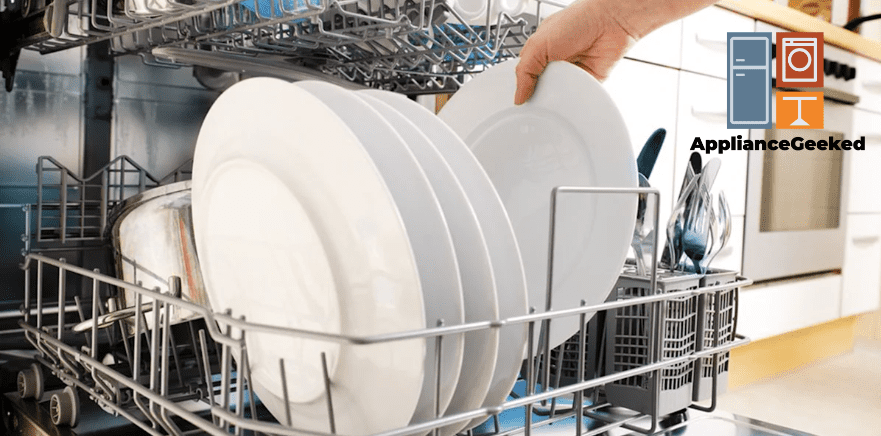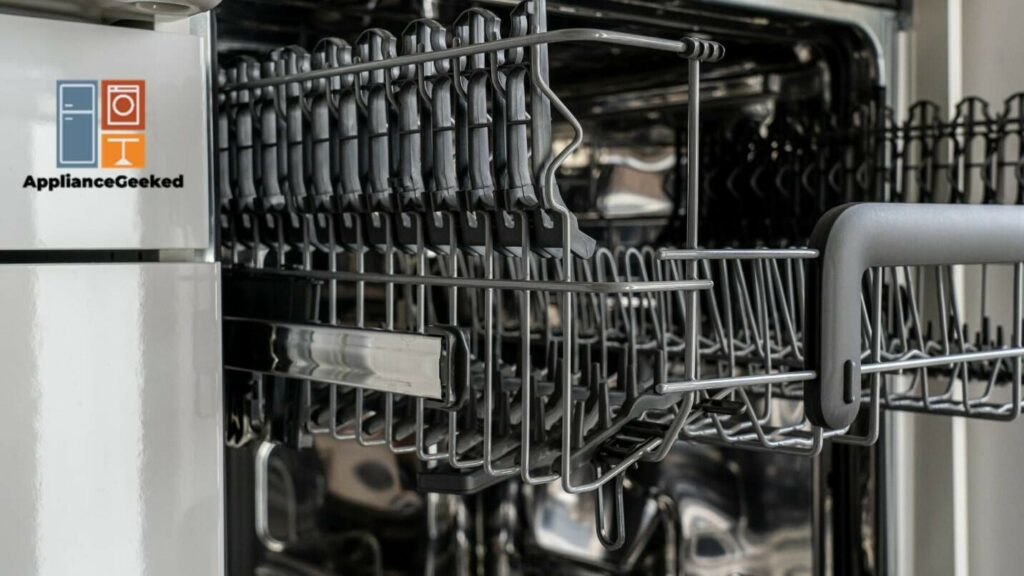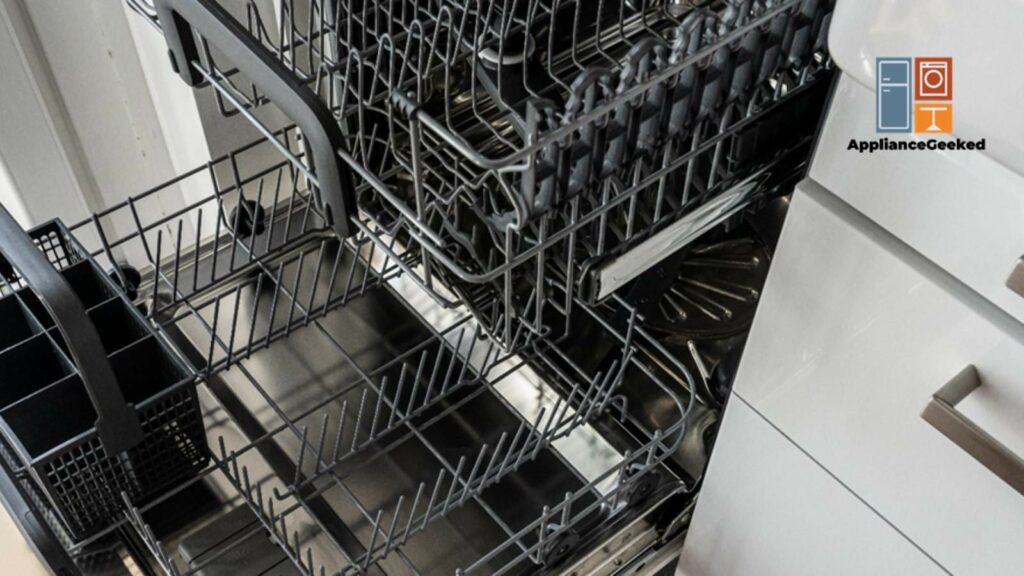Is your Samsung dishwasher making an unusual noise and isn’t draining properly? These are telltale signs of what’s causing the 3C error code to pop up.
Let’s talk about what this error means and how you can fix it.
What does the 3C error code mean?
The 3C error means that your dishwasher’s pump isn’t working properly. This may be due to a broken drain impeller, motor, or solenoid.
To fix it, unplug your dishwasher and turn off the water supply. Pull out your dishwasher, remove the pump assembly, and check for clogs and damages.
If the error is still displayed, take a resistance reading of the pump’s terminals to make sure that it is working normally. A damaged pump will need to be replaced immediately.
If you’re not sure how to do that, keep reading below for a step-by-step guide!
What causes the 3C error code?
Two of the common reasons for the 3C error code are clogging and faulty drain pump components.
Clogging usually happens when your drain filter isn’t sifting the food residue or other debris properly because of damage.
Since most filters have soft screens, they are vulnerable to broken glass pieces or other sharp objects that have entered the dishwasher. When this debris breaks through the filter, they are headed straight to your drain pump.
On the other hand, drain pumps are also vulnerable to wear and tear. When they are worn out, your dishwasher will drain slowly or not at all.
With that in mind, here are the parts of the pump you need to check:
Drain Impeller
The drain impeller is responsible for forcing the water from your dishwasher’s tub into the drain hose.
If foreign contaminants sneak past the filters, the impeller is the first to take the hit.
The foreign debris could block the impeller and stop it from turning properly. This could also damage the component entirely.
Solution: Clean the impeller and make sure that there is no debris or dirt build-up that’s stopping it from spinning freely.
Also, take note that it is normal for the impeller to spin with a slightly jerky motion because of the magnet. So don’t be alarmed when this happens during your inspection.
However, if the impeller is damaged, you’ll have to replace the assembly entirely. Continue reading below to learn how to replace your drain pump.
Drain Motor
The drain motor helps the draining cycle by powering the impeller to spin. If the motor fails, so will the impeller.
When the motor’s bearing is worn out, you’ll often hear a loud squeal coming from your dishwasher.
On the other hand, a low-humming sound indicates that your pump motor is no longer turning the impeller. This will result in standing water in your dishwasher tub or leaks.
Solution: First, check inside the pump’s housing chamber and make sure that there’s nothing blocking it.
Once you have cleaned the motor pump and the chamber, take a resistance reading using a multimeter. A functioning pump motor should have a reading of around 20-40 Ohms.
If the multimeter shows a reading beyond the range, it could mean that your pump is damaged and needs to be replaced.
Drain Solenoid
The drain solenoid is responsible for opening and closing the exit valve and is triggered by an electrical signal during the drain cycle.
If the solenoid is stuck in a closed position, the wastewater won’t be able to go into the drain hose, much less the sink drain.
Even if the motor pump and the impeller work perfectly, a faulty solenoid will still cause the error.
Solution: Check the drain solenoid for continuity. If the solenoid is damaged, you’ll need to replace it entirely.
How To Fix the 3C Error Code
As you may have noticed, any damaged parts in the pump will require a new replacement.
However, removing and installing a new dishwasher pump needs a certain level of technical skills and know-how.
If you are not confident in fixing it yourself, call an expert to help you.
Since a new drain pump can cost around $150 – $200, many dishwasher owners are opting to DIY the reinstallation to save from labor costs.
So if you are committed to doing it yourself, here is a step-by-step guide on how to remove your old drain pump and install a new one.
How to Remove Your Old Dishwasher Pump
Step 1: First, unplug your dishwasher. To make sure that there is no more residual power, try pressing the power button and check if the panel lights up.
Step 2: Turn off the water supply valve.
Step 3: Unscrew the lower access panel and remove it. Be sure not to lose any screws for later.
Step 4: Carefully unthread the water supply line from the inlet valve using a 5/8th inch wrench. Place a towel underneath to catch some spills.
Step 5: Unscrew the junction box cover and take it off. Remember the location of the wires.
Step 6: Disconnect the wires by untwisting the wire nut.
Step 7: Unthread the strain relief nut and detach it from the junction box.
Step 8: Loosen and disconnect the drain hose from the garbage disposal or the sink drain. Since you’ll be pulling the machine out, feed the hose through the cabinet hole.
Step 9: Carefully pull your dishwasher out. Adjust the leveling legs down if necessary by turning the adjustment rod clockwise.
Step 10: Once the dishwasher is out, slowly tip it back so that it’s resting on its rear panel. Make sure to move the drain hose out of the way to avoid damaging it.
Step 11: Remove the bottom access panel by unthreading the screws. Disconnect the leak sensor wire connector and set the panel aside.
Step 12: Lift the locking tab using a small flathead screwdriver. Slightly turn the drain pump counterclockwise to detach it.
Step 13: Lastly, disconnect the wires from the old drain pump to remove it completely.
How to Install Your New Dishwasher Pump
Once you have disconnected the old pump, you can test it to see if it’s still worth saving or if you’ll need to install a new one.
If you have decided on the latter, here’s how you can do it.
Step 1: First, connect the wires to the terminals of your new drain pump.
Step 2: Put the drain pump into the chamber and make sure that it is aligned properly. Rotate the pump slightly clockwise to secure it in place.
Step 3: Connect the leak sensor wire connector.
Step 4: Grab the bottom access panel that you’ve set aside and lightly snap the retaining tabs back into place. Secure the panel by rethreading the screws.
Step 5: Now, you can return the dishwasher to an upright position.
Step 6: Look at the rear panel and make sure that the water supply line, power line, and drain hose are in the right channels.
Step 7: Gently push the dishwasher back into the cabinet while making sure that the drain hose has been inserted back into the cabinet wall.
Step 8: If you have adjusted the leveling legs before, make sure to rotate them back properly to prevent your dishwasher from tilting.
Step 9: Secure your dishwasher to the cabinet by reattaching the screws into the mounting bracket.
Step 10: Pull the rest of the drain hose to reinstall it to your garbage disposal or sink drain. Make sure that the hose has a loop that is a few inches above the connection point.
Step 11: Set the wire strain relief back into place inside the junction box and secure it with the strain relief nut.
Step 12: Secure the wires back together using the wire nuts. Make sure that the wires are joined correctly as when you disconnected them.
Step 13: Align the cover of the junction box and rethread its screws.
Step 14: Reconnect the water supply hose to the inlet valve. Make sure that it’s attached tightly to avoid gaps and leaking in the future.
Step 15: Finally, reposition the lower access panel and screw it back in place.
Step 16: Dry the wet areas and turn the water supply valve back on. Plug your dishwasher back to restart it.
Step 17: Test to see if your new dishwasher pump is working properly by running a cycle.
Replacing a drain pump may be a little expensive, but with correct usage and regular maintenance, it will last you for more than 10 years.
This means that you’ll be able to enjoy your Samsung dishwasher much longer.
And there you have it! By following our guide above, you’ll be able to remove that pesky 3C error code off your Samsung dishwasher panel in no time!
If it’s a little outside your comfort zone, don’t hesitate to ask for the help of a professional.




